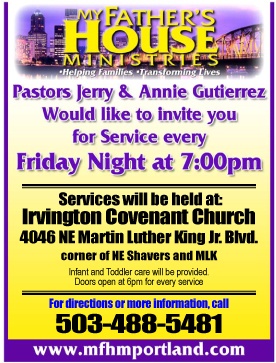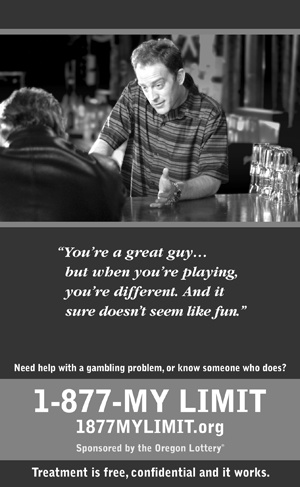 |
 |
 |
 |
A 15-year-old shot in the chest just after noon on Sunday told police he had also been shot the day before.
The unidentified youth was found Feb. 8 in the 4600 block of Northeast Sumner Street. Police say he was shot near 42nd and Killingsworth, but was able to get to a friend's house nearby where he received emergency assistance.
On Saturday night, the same youth was reportedly shot near the corner of Northeast 15th and Alberta streets. Police reportedly responded to shots fired calls at that location, but didn't find anything.
Officials say he is recovering, but remains gravely injured – and refuses to cooperate with the investigation.
The police this week reported three call-outs for the Gang Violence Response Team unit, after zero calls during Operation Cool Down from Jan. 16 to 23.
Five guns were confiscated during that period, and arrests were made, with no injuries or shots fired calls.
City and police officials also say that, although they feared more shootings during the Lloyd Center run of "Notorious" – which took in the highest box office profit of any area theater during its opening days – no incidents occurred, in part, they say, because an array of outreach workers, law enforcement and others turned out at the theater to diffuse tensions.
Meanwhile, on Jan. 24 a mentally ill 24-year-old from Milwaukie shot two teens to death and wounded seven others in front of a downtown nightclub before turning the gun on himself.
All this, as juvenile crime in Multnomah County dropped 11 percent in the past two years, according to a report from the Multnomah County Department of Community Justice.
Although the Portland Police Hotspot Enforcement Action Team has confiscated hundreds of guns since it was activated last June, the issue persists: Where are the youth getting all these weapons?
Patrick Callahan, senior deputy District Attorney for Multnomah County, says the guns used in street violence come from many sources.
"The number of guns seized doesn't always give us an idea of how they were obtained," he says. "Not all the guns are illegal in and of themselves, right?"
Callahan says often, the only thing unlawful about street weapons is the person who's got them in their hand, in that they're a felon, or the way in which they're being used — they're being used to shoot at somebody or something.
"So then trying to trace where they come from, sometimes it's just hard to tell."
In the case of Erik Salvador Ayala, who fired into the crowd outside The Zone nightclub Jan. 24, taking three lives including his own, the 9 mm handgun he used was obtained legally at a local gun shop.
Callahan listed what he believes are the most common sources of guns used in street crimes.
"Some guns are taken in house burglaries so they end up being stolen, some of them of course are reported stolen, some of them are not.
"Then there is a kind of secondary economy in guns, in hand-to-hand sales, private party transactions — the people on the street buying from each other," he said. This is probably the most common way that criminals obtain weapons, he said.
"There's gun shows where there are some checks that are in place, which is a good thing to check for somebody's status as a felon, but understand that if they're not a felon, it's not like you have to show good moral standing to buy a gun. The Constitution guarantees your right to keep and bear arms."
Callahan said that infrequently, commercial burglaries are reported such as at sporting goods stores, where a large number of guns is taken.
He said such a robbery last year in Vancouver saw hundreds of guns stolen, but almost every weapon was recovered by police.
"I'm sure there's some kind of underground pipeline for guns but it's hard to get a fix on that," Callahan said. "If you look at the numbers of handguns that are produced and available in the United States — there's a lot of guns."
I fact, at the group CeaseFire Oregon's annual gun turn-in event last Nov. 1, 424 weapons were brought in.
Rob Ingram, director of the Mayor's Office of Youth Violence Prevention – who says he himself was once involved in the Portland gang scene in his youth — said in an interview last summer that the availability of guns in Northeast Portland is unprecedented.
"The number of guns on the street, the brazenness of the youth with the guns in their hands, the size of the guns, the amount of ammunition – those things are very strange, not normal, not something that we would ever have predicted," he said.
"First thing I think we really have to do is we have to figure out how many guns are really out there."
Ingram added, "I think personally that parents and teachers need to be more aware of how these kids are getting the guns and where they're stashing them."
A new effort by youth probation officers for the Multnomah County Department of Justice involves giving more help to parents who are too intimidated by their children to intervene in the young peoples' violent activities.
At a meeting of the Portland Gang Violence Task Force in January, two local probation officers said they have started telling parents and guardians who suspect their teens have weapons not to confront them on it – but rather to call in the probation officers to check out the premises.
The probation officials at the meeting exchanged cellphone numbers with law enforcement officers to ensure they had backup when the time came for such a home check on youth suspected of possessing firearms.






















































































































































































































































































































